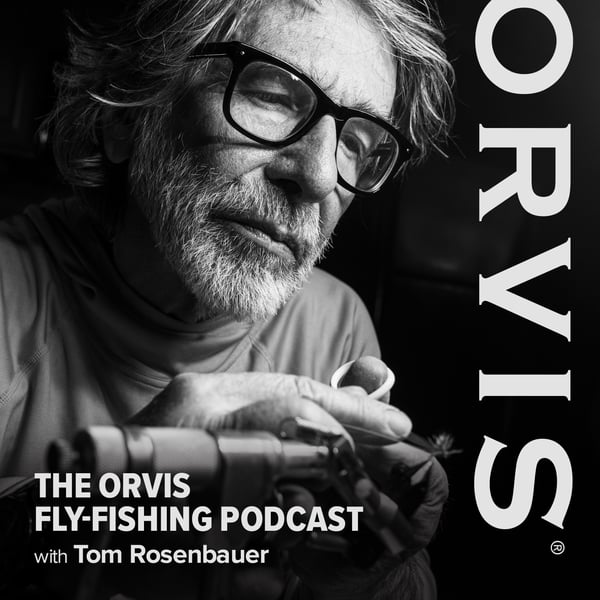Backcast: George Daniel on Winter Fly Fishing
The Orvis Fly-Fishing Podcast
James Hathaway
4.8 • 1.9K Ratings
🗓️ 24 February 2025
⏱️ 83 minutes
🧾️ Download transcript
Summary
This episode was originally published on January 30th, 2021
This week, continuing our series of podcasts on winter fly fishing for trout, I interview George Daniel, author and guide. George is also an Orvis ambassador and field tester, and teaches fly fishing at Penn State. As you'll discover, there are many similarities with winter fishing in other parts of the country, along with some flies and techniques a bit more appropriate for the Northeast.
In the Fly Box this week, we have some great tips and questions, including:
Do you use touch dubbing, split thread dubbing, and composite loop dubbing techniques?
I'm looking for a fly line to fish streamers for bass, trout, and panfish. Which line should I get?
What leaders do I need for my Clearwater Trout Spey setup, for both Skagit and Scandi lines?
What's your technique for catching largemouth bass, and what are your favorite flies?
Why can't I get my dubbing noodle to behave?
Which intermediate line should I get for fishing streamers and indicators in four to eight feet of water?
A great tip on a method for wetting marabou and other materials without putting them in your mouth.
I went fishing before a cold front and got skunked. I thought fishing was supposed to be good before a cold front.
What line and leader and tippet would you use for trout in lakes in 15 feet of water?
Transcript
Click on a timestamp to play from that location
| 0:00.0 | Hi and welcome to the Orvis fly fishing podcast. |
| 0:11.2 | This is your host Tom Rosenbauer, and today's guest is the great George Daniel. |
| 0:17.1 | And in our continuing series of winter fly fishing, we're going to be talking to George and this time about winterfly fishing in the Northeast, specifically central Pennsylvania. |
| 0:29.6 | But George's ideas should apply anywhere in the northeast where winter fishing is legal and accessible. |
| 0:38.9 | So George has always got some great ideas, and I think you'll enjoy today's interview. |
| 0:47.4 | But first, let's do the flybox. |
| 0:49.7 | And if you have a question for the flybox, you can send it to podcast at orvis.com. |
| 0:57.1 | You can include a voice file if you want, or you can just type your question into an email, and I will try to answer it. |
| 1:06.1 | So, on to the flybox. |
| 1:08.0 | The first one is from RK, and it's flytime question. And I have to apologize |
| 1:12.5 | in advance because I'm not going to be a lot of help in these questions, but maybe in answering |
| 1:21.5 | or not answering the questions, I'm going to lead you in an easier direction, RK. |
| 1:28.4 | So I think you'll see when I answer these, what I'm talking about. |
| 1:34.4 | RK asks, need some advice from the in-house Orvis fly-tying sage, |
| 1:39.2 | been messing around with dubbing techniques to get shaggy or flies. |
| 1:43.1 | This has risen to a bunch of questions |
| 1:45.2 | that I hope you can answer. First one is touchdubbing. When, if at all, do you personally use |
| 1:51.9 | touchdubbing technique? Do you have preferred dubbing types? Muscat or mink for touchdubbing? Do you |
| 1:57.8 | have a preferred dubbing wax? Do you have a preferred thread that you use for this technique? Do you spin your thread after applying the dubbing? Do you have a preferred dubbing wax? Do you have a preferred thread that you use for |
| 2:01.7 | this technique? Do you spin your thread after applying the dubbing? Is spinning your thread after |
| 2:06.7 | your touch dub even a technique? So I'm going to ask these one at the time. RK, I've never used |
| 2:13.2 | touch dubbing and I honestly don't see an advantage to it. I think it's going to, |
... |
Please login to see the full transcript.
Disclaimer: The podcast and artwork embedded on this page are from James Hathaway, and are the property of its owner and not affiliated with or endorsed by Tapesearch.
Generated transcripts are the property of James Hathaway and are distributed freely under the Fair Use doctrine. Transcripts generated by Tapesearch are not guaranteed to be accurate.
Copyright © Tapesearch 2025.

